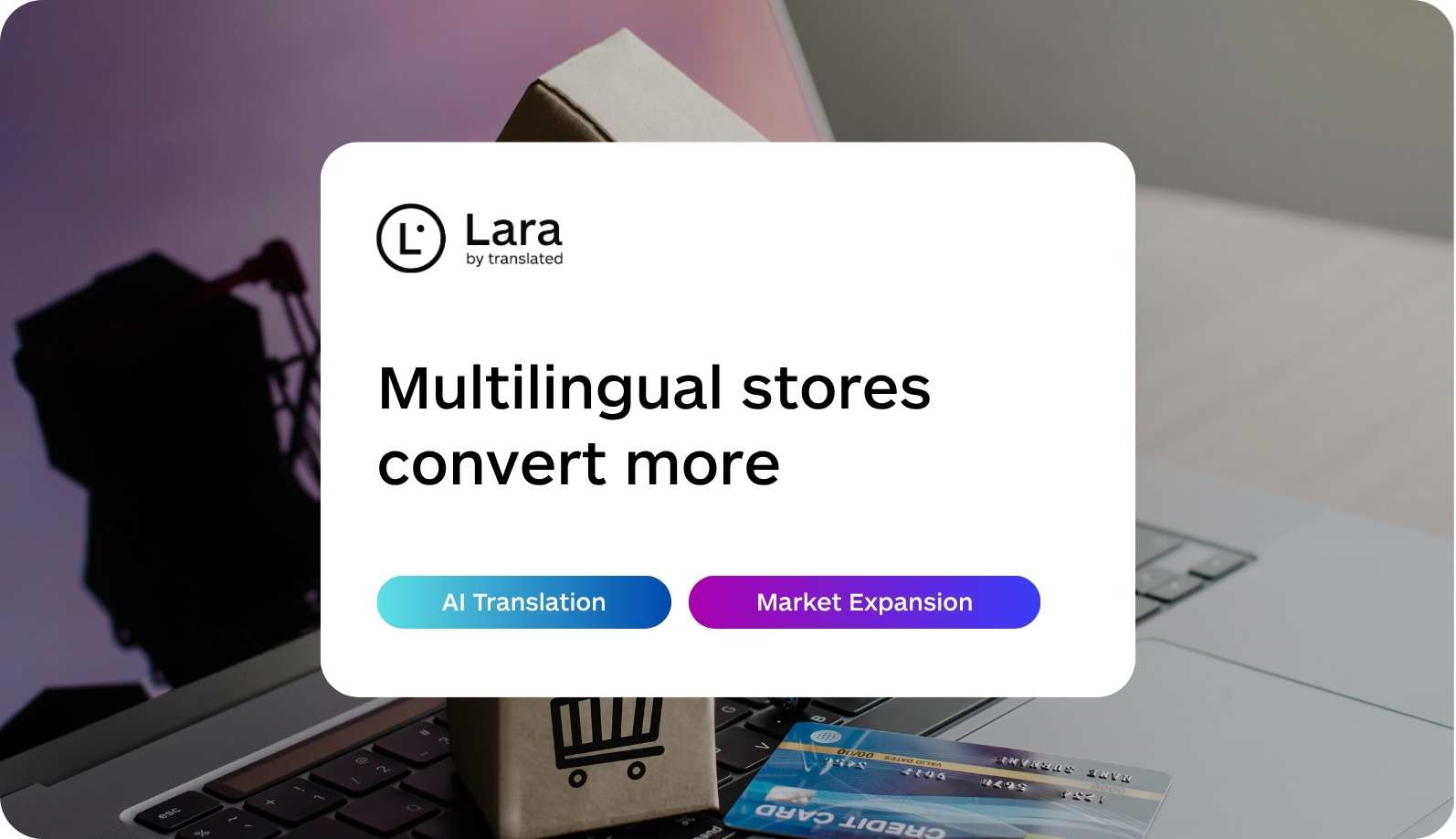Ever tried shopping on a website in a language you don’t speak? It’s frustrating and you probably didn’t hit “Buy.”

That’s why going multilingual with your online store isn’t just smart, it’s essential. People are far more likely to trust and buy from brands that speak their language. It’s not just about understanding the product; it’s about feeling seen.
As cross-border ecommerce keeps booming, businesses that localize now aren’t just reaching more people, they’re building real connections that lead to long-term growth.
Understanding the reach advantage
The most immediate advantages of multilingual ecommerce become apparent when you consider the numbers. While 58.8% of web content exists in English (source: W3tech), that still leaves 41.2% of potential customers browsing in other languages. More critically, research consistently shows that 65% of consumers are more likely to convert when reading product pages in their native language, and a substantial 40% simply won’t purchase from websites that aren’t available in their preferred language (source: CSA Research, 2020 – “Can’t Read, Won’t Buy – B2C”).

These statistics reveal a massive opportunity gap. When your ecommerce store operates exclusively in English, you’re essentially turning away nearly half of potential international customers before they even have a chance to evaluate your products. The businesses that recognize this reality and act on it gain an immediate competitive advantage in global markets.
Beyond the obvious international expansion benefits, don’t overlook domestic opportunities. In markets like the United States, Spanish represents the second most spoken language, creating significant untapped potential even within your home territory. Language preferences in online shopping vary greatly, and catering to these preferences can unlock new customer segments you may never have considered.
How multilingual websites boost conversions
The connection between language accessibility and conversion rates goes deeper than simple comprehension. When customers encounter your store in their native language, several psychological and practical factors combine to create a more compelling shopping experience.
Cognitive load plays a crucial role here. When people read content in their second or third language, their brains must work harder to process information, creating mental fatigue that often leads to abandoned shopping carts. Native language content eliminates this barrier, allowing customers to focus entirely on evaluating your products rather than struggling to understand your descriptions.
Trust formation also accelerates when customers interact with content in their preferred language. Familiar phrases, cultural references, and linguistic nuances create an immediate sense of authenticity and credibility. This psychological comfort translates directly into higher conversion rates and increased average order values.
The impact of localization on customer experience extends throughout the entire purchase journey. From initial product discovery through checkout completion, customers navigating in their native language demonstrate measurably lower bounce rates and higher engagement metrics. They spend more time exploring your catalog, view more product pages, and show greater willingness to complete complex transactions.
Ecommerce localization benefits for SEO
International search engine optimization represents one of the most significant yet underestimated ecommerce localization benefits. When you properly localize your store for multiple languages, you’re not just translating content—you’re creating entirely new pathways for organic discovery in international markets.

Search engines treat properly localized content as distinct from your original language version, meaning you can potentially rank for the same product categories across multiple geographic regions simultaneously. This multiplication effect can dramatically increase your organic traffic without proportionally increasing your marketing spend.
Keyword research becomes particularly important in this context. Direct translation of your English keywords rarely captures how people actually search in other languages. Local search behaviors, cultural contexts, and regional terminology variations all influence how potential customers discover products online. International ecommerce strategy must account for these nuances to achieve meaningful SEO results.
Technical implementation matters enormously here. Proper URL structure, hreflang tags, and metadata localization signal to search engines that you’re serious about serving international customers. When executed correctly, these technical elements help search engines understand which version of your content to show to which audiences, maximizing your visibility across all target markets.
Why local language matters in ecommerce
The emotional dimension of language in commerce cannot be overstated. Why local language matters in ecommerce extends far beyond mere communication—it touches the core of how customers perceive your brand’s authenticity and commitment to their market.
When customers encounter product descriptions, policies, and support content in their native language, they perceive your business as more trustworthy and established. This perception directly influences purchasing decisions, particularly for higher-value items where trust plays a critical role in overcoming purchase hesitancy.
Cultural nuances embedded within language also affect how customers interpret your brand messaging. Colors, symbols, payment methods, and even product presentation styles carry different meanings across cultures. Effective localization addresses these subtleties, ensuring your brand resonates positively rather than creating unintended negative associations.
Customer service expectations vary significantly across markets, and language accessibility directly impacts satisfaction levels. When customers can access support in their preferred language, resolution times decrease and satisfaction scores improve. This enhanced service experience (multilingual ecommerce) contributes to higher customer lifetime value and stronger word-of-mouth recommendations.
Building a multilingual strategy for online stores
Developing an effective multilingual strategy for online stores requires careful planning and phased implementation. Rather than attempting to localize your entire catalog simultaneously, focus initially on your highest-converting products and most critical customer touchpoints.
Start with markets where you already see organic international traffic or customer inquiries. These regions represent proven demand for your products and offer the highest probability of immediate return on your localization investment. Analyze your existing analytics data to identify which countries generate the most engagement and focus your initial efforts there.
Content prioritization becomes crucial during implementation. Product descriptions, checkout processes, shipping information, and return policies should receive immediate attention since these elements directly impact conversion rates. Secondary content like blog posts and detailed FAQs can follow in subsequent phases.
Quality control throughout this process cannot be compromised. While AI-powered translation tools have improved dramatically, human oversight remains essential for ensuring cultural appropriateness and maintaining your brand voice across languages. Professional translators and native speakers provide the cultural context and nuanced understanding that automated systems still struggle to replicate consistently.
Increase ecommerce sales with translation using advanced AI technology
Modern translation technology has evolved to support sophisticated multilingual ecommerce translation needs without sacrificing quality or authenticity. Lara Translate represents the latest generation of AI-powered translation solutions specifically designed for business applications, offering the speed and scalability that growing ecommerce operations require.

Unlike generic translation tools, Lara Translate focuses on maintaining consistency across large catalogs while preserving the specific terminology and brand voice that define your business. The platform supports many languages, enabling comprehensive international expansion while maintaining the human touch that customers expect from professional business communications.
The technology integrates seamlessly with existing ecommerce workflows, allowing for real-time updates and maintaining synchronization between your original content and translated versions. This capability proves particularly valuable for businesses with frequently changing inventory or seasonal promotions that need consistent messaging across all markets.
However, successful implementation still requires human expertise for cultural adaptation and quality assurance. The most effective approach combines AI efficiency with human insight, ensuring that translation and UX considerations work together to create genuinely engaging customer experiences rather than merely functional translations.
Long-term growth through customer loyalty
The impact of localization on customer experience extends well beyond initial conversions to influence customer lifetime value and brand loyalty. When customers feel genuinely understood and valued through native language experiences, they develop stronger emotional connections to your brand that transcend simple price comparisons.
Repeat purchase rates demonstrate measurably higher performance among customers who shop in their preferred language. These customers also show greater tolerance for minor service issues and higher likelihood to recommend your business to others within their linguistic community.
Multilingual ecommerce customer service capabilities amplify these loyalty effects. When customers can resolve issues or ask questions in their native language, satisfaction scores increase significantly. This enhanced support experience creates positive associations that influence future purchasing decisions and reduce customer acquisition costs through improved retention.
The compound effect of these improvements creates sustainable competitive advantages that become increasingly difficult for competitors to overcome. As your multilingual capabilities mature and your international customer base grows, you develop market insights and cultural understanding that barriers to entry for less prepared competitors.
For businesses ready to embrace international expansion, the question isn’t whether to implement multilingual capabilities, but rather how quickly and effectively you can execute this transformation. The companies that act decisively on multilingual opportunities position themselves to capture disproportionate market share as global ecommerce continues its rapid evolution.
FAQs
Why should I consider creating a multilingual ecommerce store?
Operating in multiple languages allows your brand to connect with global customers more authentically. Consumers are more likely to purchase when they feel understood and valued in their native language, leading to improved trust, engagement, and conversion rates.
Isn’t English enough for reaching a global audience?
No. While English dominates a large portion of web content, over 40% of global users prefer to browse in other languages. Moreover, 65% of consumers are more likely to buy when information is presented in their native tongue, and 40% will not purchase at all if their language isn’t available.
How does language affect conversion rates in ecommerce?
Native-language content significantly reduces cognitive load and enhances customer trust. It creates a more seamless and emotionally resonant experience, resulting in lower bounce rates, longer session times, and higher average order values.
Can going multilingual help with SEO?
Absolutely. Localized content allows your store to appear in international search results as unique, language-specific entries. With appropriate keyword research and correct technical implementation (e.g., hreflang tags, localized metadata), multilingual SEO boosts visibility and organic traffic in multiple markets.
Is localization only relevant for international markets?
Not at all. Even domestic markets like the U.S. have substantial non-English-speaking populations—Spanish being a prime example. Catering to these groups can unlock untapped local growth opportunities.
This article is about
- How multilingual ecommerce stores enhance market reach, customer trust, and conversions
- The SEO advantages of localized content for increasing organic traffic in global markets
- Strategic approaches to implementing multilingual content, including phased rollout and content prioritization
- The role of AI-powered translation tools in scaling international ecommerce while maintaining quality





